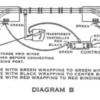I am planning on building a small 027 layout. I have some fat wheeled Marx and prewar engines, so it has been suggested I consider the Marx 1590 switches. I have no experience with these. I was at a local train show today that was quite small. One vendor had a few boxes of junk that he was trying to sell off. In one box, I found a single Marx 1590 RH that I bought for $3.00. I figured I would look it over and familiarize myself. I have some questions.
1. When I got home, I moved the swivel rails back and forth while cleaning the dirt off. They seemed to move freely, but at one point they locked in the curve position. They don't seem to want to move now. Is it supposed to do that? If so, how do they unlock?
2. On top of the red coil cover, there is a small black box with three lenses. Two of the lenses are loose in their bevel and flip over. I take it these are some kind of indicator and the lenses shouldn't flip over. Is this correct?
3. I suspect that these switches are constant voltage through the controller, based on wiring diagrams I have seen online. Is that correct?
Any information would be appreciated.















